|
|
|
| My Favourite Planet > English > People > Aristokles |
|
| |
Aristokles
Aristokles (Ἀριστοκλε͂ς or Ἀριστοκλῆς), was a Greek sculptor, working in Attica at the end of the 6th century BC. Nothing is known about his life, and only his name is known from signatures on surviving parts of funerary monuments from Attica. These may be have been works by more than one sculptor of this name.
Pausanias mentioned works by a sculptor or sculptors called Aristokles, thought to have been working in the 6th - 5th centuries BC:
Aristokles of Kydonia (also referred to as Aristokles the Elder, perhaps around 600-568 BC);
Aristokles of Sikyon (Aristokles the Younger), perhaps the grandson of the former, and mentioned by Pausanias as the brother of Kanachos of Sikyon (the Elder), thought to have been working around the same time (around 540-508 BC);
Aristokles, son of Kleoitas, perhaps working in the early-mid 5th century BC.
Aristokles was not an uncommon name, and no connection has been established between these artists and the sculptor (or sculptors) working in Athens around this time.
The grave stele of Aristion
A grave stele of Pentelic marble, dated to around 520-510 BC, and found in 1838 in the ancient cemetery of Velanideza, eastern Attica [1], is signed at the bottom "work of Aristokles" (ἔργον Ἀριστοκλέος, ergon Aristokleos). The rectangular base of the stele is also inscribed with the name of the deceased man Aristion (Ἀριστίονος, Aristionos). It has been suggested that he may have been the sculptor Aristion of Paros. It has even been mooted that Aristokles may have been Aristion's successor, and that the two artists were relatives. The scribe who cut the inscription is thought to have been the same person who inscribed bases for Aristion of Paros and Phaidimos. [2]
The stele itself has a finely sculpted and painted low relief showing the full-length figure of a bearded, barefooted hoplite wearing a helmet, a cuirass over a chitoniskos (short tunic) and greaves (shin armour), and holding a spear in his left hand. The background was painted red, and some of the colour can still be seen, as well as traces of red, blue and yellow on the figure. The tip of the beard as well as the top of stele, including the top of the helmet and the finial, are missing.
Stele height 202 cm, width 14 cm.
Base height 24 cm, width 72 cm, depth 43 cm.
National Archaeological Museum, Athens. Inv. No. 29.
A plaster cast of the stele, without the base, is on display in the Ashmolean Museum, Oxford. Inv. No. D4.
The lower part of a similar Attic grave stele, made of Hymettian marble and dated to 525–515 BC, shows the legs and feet of a hoplite and the lower part of spear. In the panel below the figure is a painted relief of an armoured warrior mounting a four-horse chariot, probably a competitor in an apobates race.
Metropolitan Museum of Art, New York. Inv. No. 38.11.13.
See: metmuseum.org/art/collection/search/253566
Aristokles' signature has been found on parts of funerary monuments, all dated around 525-500 BC, from Kerameikos, Athens, now in the Kerameikos Archaeological Museum:
The base of a funerary statue, possibly of a horseman, for Xenophantos son of Sophilos. Inv. No. I 389 (see below).
Base for a marble kouros statue for a Carian.
Inv. No. I 190 (see below).
Fragment of a funerary stele for a woman. Inv. No. P 1265. |
|
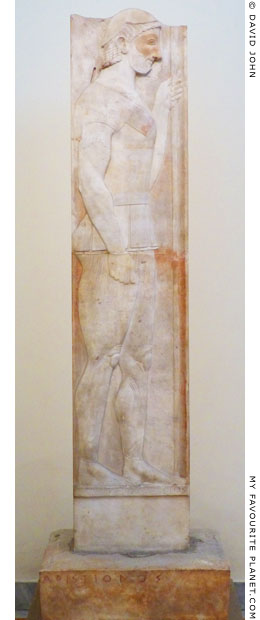
The grave stele of Aristion,
signed on the base by Aristokles.
See larger photos below. |
|
| |
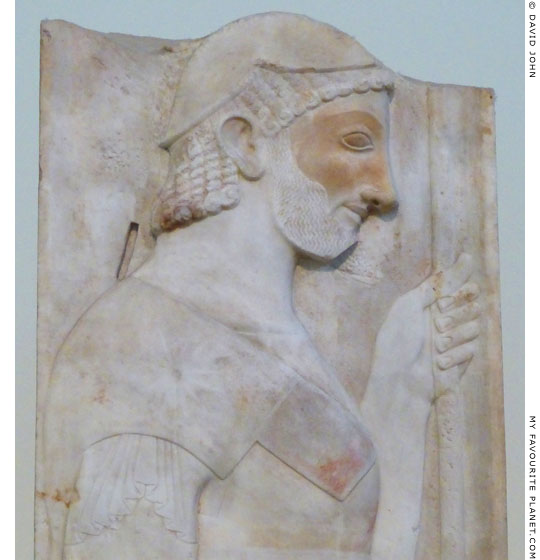
Detail of the relief of Aristion. The carving of the hair, beard and folds of the
sleeve are particularly fine and detailed. There is a lightly sculpted star on the
shoulder, and the figure is also decorated with Meander and zig-zag patterns.
The museum labelling describes the stele as
"one of the most beautiful Attic grave steles". |
| |
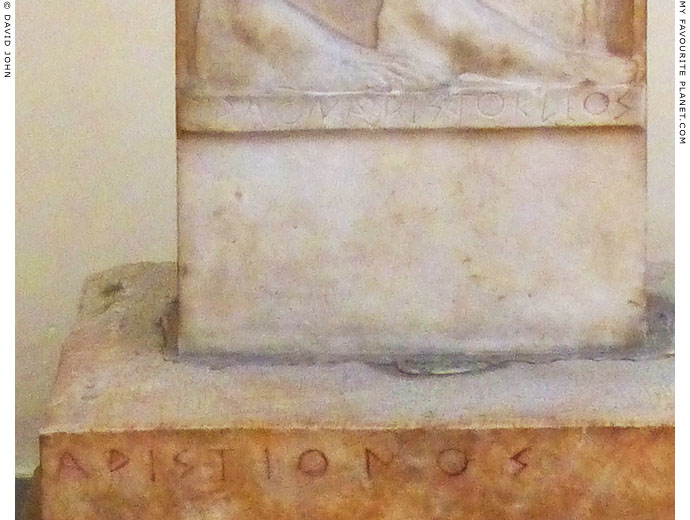
The signature of Aristokles beneath of the feet of the relief figure,
and the name of the deceased man Aristion inscribed on the base.
ἔργον Ἀριστοκλέος (ergon Aristokleos, work of Aristokles)
Ἀριστίονος (Aristionos, Aristion's)
Inscription IG I³ 1256. |
| |
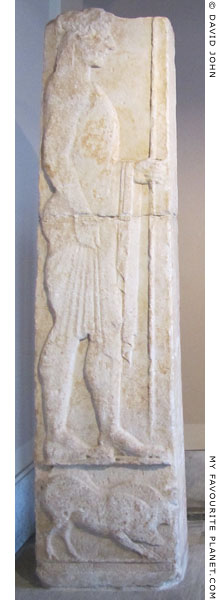
A warrior with a spear on an
Archaic marble grave stele from
the Greek island of Syme. In the
lower register is a wild boar.
1st half of the 6th century BC.
Local marble.
Istanbul Archaeological Museum.
Inv. No. 507 T. Cat. Mendel 14. |
|
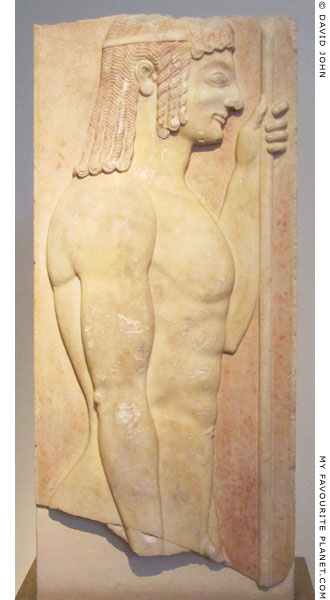
Fragment of an Archaic Attic gravestone with
a painted relief of young doryphoros (spear
carrier), facing right, on a red background.
550-540 BC. Parian marble. Found built into
the Themistoklean Wall, Athens.
National Archaeological Museum, Athens.
Inv. No. 7901. |
|
| |
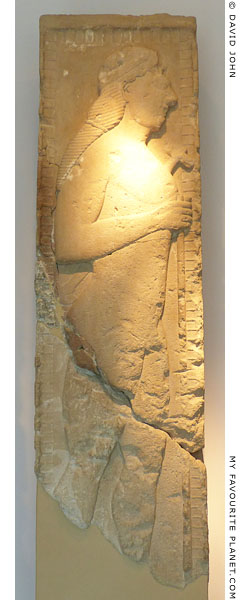
Part of an Archaic poros limestone
grave stele with a relief depicting
a male, the deceased, shown in
profile, walking to the right, holding
a staff and a sword. Surviving traces
of paint suggest that the figure was
painted red, with brown hair against
a blue background. The border of
the stele was also red.
570-560 BC. Found to the west of the
Tripopatreion, Kerameikos, Athens.
Kerameikos Archaeological Museum.
Inv. No. P 1132. |
|
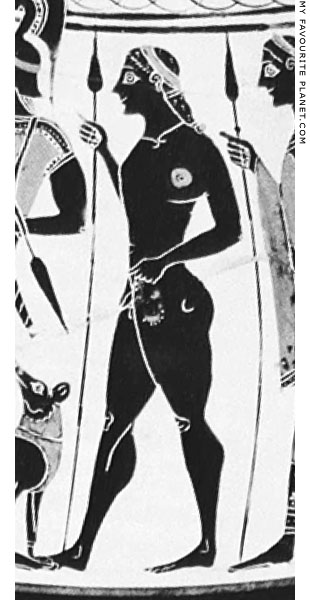
A naked youth holding a spear. Detail of
a painting on an Attic black-figure panel
amphora, attributed to the Amasis Painter,
working in Athens around 560-515 BC.
Metropolitan Museum, New York.
Inv. No. 56.171.10. |
|
| |
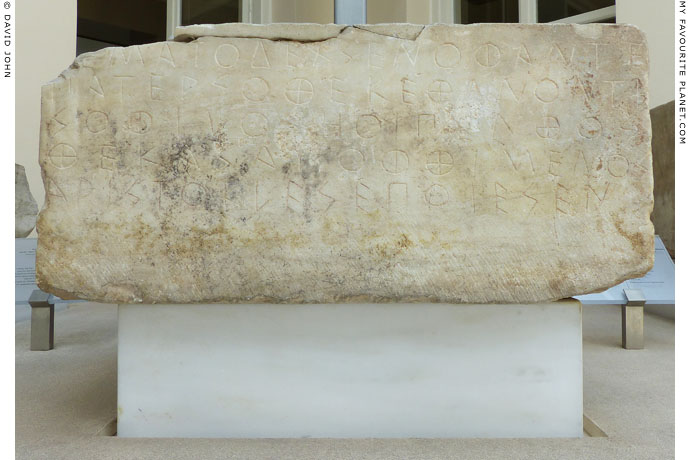
The base of a funerary statue, possibly of a horseman, signed by Aristokles. In the elegy
inscribed on the front of the long base Sophilos addresses his deceased son Xenophantos.
[σ]ε͂μα τόδε, Χσενόφαντε,
πατέρ σο<ι> θε͂κε θανόντι /
Σόφιλος, ℎο͂ι πένθος
θε͂κας ἀποφθίμενος.
Ἀριστοκλε͂ς ἐποίεσεν.
This monument, Xenophantos,
was erected by your father
Sophilos for the great sorrow
you caused by your loss.
Aristokles made it.
Inscription IG I³ 1218 (also CEG I 50; DNO I 376).
520-510 BC. Found in a tower of the Dipylon Gate, Kerameikos, Athens.
Kerameikos Archaeological Museum. Inv. No. I 389. |
| |
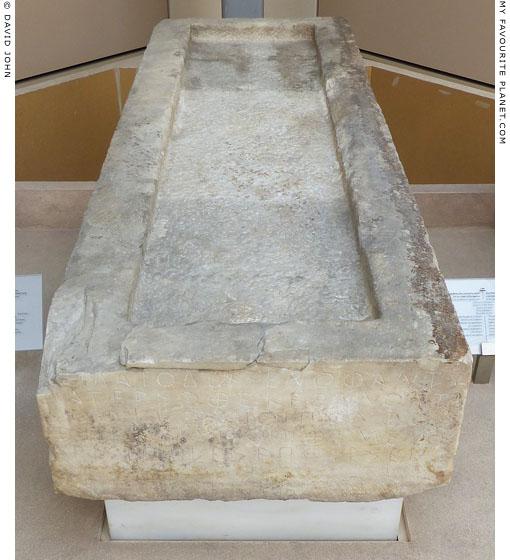
The top of the base of the funerary statue for Xenophantos. |
| |
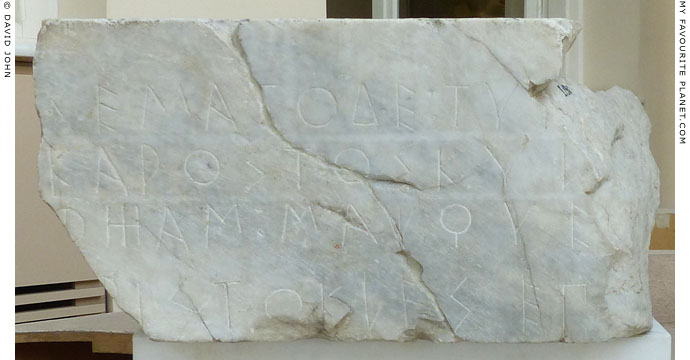
Fragment of a base of a marble kouros statue, signed by Aristokles, for the deceased
"Tyr... from Caria, son of Skylax". The damaged and incomplete inscription includes a line
in Carian script (for more about Carians see Herodotus and Panyassis of Halicarnassus)
σε͂μα τόδε ∶ Τυρ̣- -
Καρὸς το͂ Σκύλ[ακος]
(in Carian script) s-e-a-s S-a-k-q-u-r-[-].
[Ἀ]ριστοκλε͂ς ἐπ[οίεσεν(?)]
This is the tomb of Tyr... from Caria,
son of Skylax.
(in Carian) Monument of Skylax.
Aristokles made it.
Inscription IG I³ 1344.
One reading of the inscription (SEG 13:36) reconstructs
the name of the deceased as Τύμ[νεο] (Tymneo, Tymnes).
520-500 BC. Found in the area of the Piraeus Gate, Athens.
Kerameikos Archaeological Museum. Inv. No. I 190. |
| |
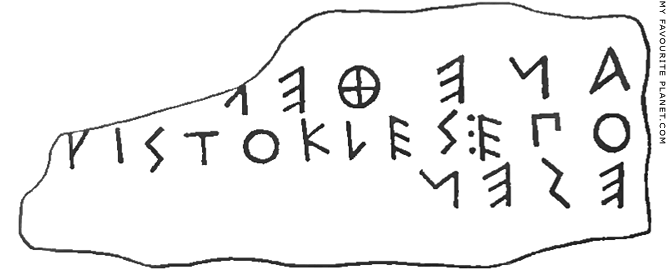
A fragment of a marble dedicatory monument, signed by Aristokles.
First reported in 1843 as being in seen built into the wall of a church on monastery
property at Hieraka, between Mount Hymettos and Mount Pentelikon, outside Athens.
It was rediscovered by the German archaeologist Habbo Gerhard Lolling (1848-1894)
on 23 August 1873 in a heap of rubble, following which this drawing was made from
a squeeze. It appears to have been subsequently lost again. At the time, the signature
was attributed to Aristokles, son of Kleoitas, thought also to be the sculptor of the
grave stele of Aristion. Height 14.5 cm, length 35 cm, height of letters 2.7 cm.
The inscription is written in boustrophedon (βουστροφηδόν, ox-turning, as in ploughing
a field), that is with the lettering and direction of the writing reversed on alternate lines.
In this case the lettering of the first and third lines is reversed and the words run right
to left. The punctuation is in the form of tricolons (or triple colon).
- - - ἀνέθεκ[εν]
[Ἀ]ριστοκλές ⋮ ἐπο[ί]εσεν.
- - - dedicated it.
Aristokles made it.
Present location unknown.
Source: Emanuel Loewy, Inschriften griechischer Bildhauer (Inscriptions of Greek sculptors),
No. 9, pages 12-13. B. G. Teubner, Leipzig 1885. At Heidelberg University Digital Library. |
| |
| Aristokles |
Notes, references and links |
 |
|
1. The discovery of the stele of Aristion at Velanideza
The American archaeologist Carl Darling Buck (1866-1955) discussed the "the stele of Aristion" in relation to a similar stele he discovered in 1888 at Ikaria, Attica (see photo, right):
"The stele of Aristion was found in 1838 in the ruined village of Velanideza, which lies about two-thirds the distance between Spata and the eastern coast of Attika, not, as is frequently stated, on the plain of Marathon, between which and Velanideza intervenes the eastern range of Pentelikon."
Carl D. Buck, Discoveries in the Attic Deme of Ikaria, 1888. Sculpture. Stele of a warrior (Plate IX). Papers of the American School of Classical Studies at Athens, Volume V, 1886-1890, pages 126-134. Archaeological Institute of America. Damrell and Upham, Boston MA, 1892. At Heidelberg University Digital Library.
First published in: Carl D. Buck, American Schoool of Classical Studies at Athens, discoveries in the Attic Deme of Ikaria, 1888, II. The stele of a warrior, Athens, November 10, 1888. In: American Journal of Archaeology and of the History of the Fine arts, Volume V (first series), 1889, pages 9-17, Plate I. Archaeological Institute of America. At the Internet Archive.
See the fragments of a colossal marble statue of Dionysus which Buck discovered at Ikaria.
2. The scribe of the inscription on the stele of Aristion
"Phaidimos shared the services of a scribe for his bases with the sculptor Aristion of Paros and with Aristokles, each known from only one extant signature, the latter's being later in the century. The association could be that of a studio, but might be slighter if such scribes were freelance."
John Boardman, Greek sculpture, the Archaic period: A handbook, page 75. Oxford University Press, 1978.
Phaidimos (Φαίδιμος) is known from his signature on the bases for three grave monuments found in Athens, dated 560-540 BC. At the time Boardman was writing Aristion of Paros and Aristokles were only known from one signature each. |
|
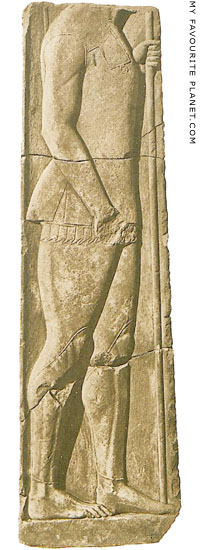
The fragmented Archaic warrior
stele found by Carl D. Buck in
a ruined Byzantine church at
Ikaria, Attica in February 1888
(the head of the figure was
found later).
Pentelic marble. Circa 530 BC.
Height 172 cm, width 41-48.5 cm,
depth 12 cm.
National Archaeological Museum,
Athens. Inv. No. 3071.
Source: Carl D. Buck,
Discoveries in the Attic Deme
of Ikaria, 1888, Plate IX. |
|
| Photos and articles © David John, except where otherwise specified. |
 |
Visit the My Favourite Planet Group on Facebook.
Join the group, write a message or comment,
post photos and videos, start a discussion... |
|
|
| |
|
|
| |
| |
 |
| |
 |
| |
 |
| |
 |
| |
 |
| |
 |
| |
George Alvanos
rooms in
Kavala's historic Panagia District
Anthemiou 35,
Kavala, Greece
kavalarooms.gr
|
| |
Olive Garden Restaurant
Kastellorizo,
Greece
+30 22460 49 109
kastellorizo.de
|
| |
Papoutsis
Travel Agency
Kastellorizo,
Greece
+30 22460 49 286
greeklodgings.gr
|
| |
|